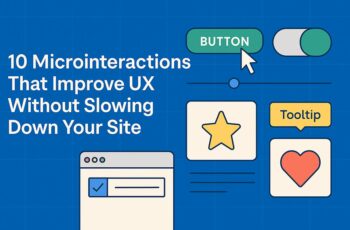Once a novelty feature, dark mode has become a staple of modern digital design. Users love it for its aesthetic, battery-saving benefits, and reduced eye strain. But by 2025, dark mode isn’t just an option — it’s an expectation.
However, designing an effective dark theme is far more nuanced than simply inverting colors. As more tools, frameworks, and systems build dark mode into their workflows, there are new standards, trends, and traps to be aware of.
Let’s break down what’s driving dark mode in 2025, the biggest mistakes designers still make, and how to do it right — without hurting UX or performance.
🔥 Trends Driving Dark Mode in 2025
1. System-Wide Preference Detection as the Default
By now, almost every OS and browser supports prefers-color-scheme. Sites that don’t respect system preferences feel outdated. In 2025, users expect your site to automatically switch to their preferred mode.
@media (prefers-color-scheme: dark) {
body {
background-color: #121212;
color: #e0e0e0;
}
}
2. Customizable Themes for Users
Increasingly, web apps and even content websites are offering theme toggles that allow users to override system settings. This adds a layer of user empowerment and personalization — now considered good UX.
3. Dark Mode as Branding
More startups and creators are designing dark mode first — or even using it as a core visual identity. Spotify, Figma, and Notion all lean into this. It’s sleek, modern, and distinct — especially when paired with neon, glassmorphism, or vibrant accent colors.
4. Accessibility-Driven Contrast Standards
Dark mode isn’t automatically easier on the eyes. In fact, low contrast and poorly chosen color palettes can cause more strain than light mode. 2025’s trend: dark doesn’t mean low-contrast.
⚠️ Common Pitfalls in Dark Mode Design
1. Simply Inverting Colors
This is the #1 mistake. Just flipping background and text colors often leads to:
- Washed-out brand colors
- Poor accessibility
- Broken visual hierarchy
Instead, design dark mode intentionally with a separate palette.
2. Using Pure Black (#000000)
Though sleek on OLED screens, pure black creates harsh contrast with light text, causing visual fatigue. Most modern dark UIs use off-black shades like #121212, #1a1a1a, or dark gray-blue tones.
3. Forgetting Shadows & Depth
Flat designs in dark mode can feel lifeless. Shadows, borders, and elevation become essential for creating separation between layers and components. Use soft glows or transparent whites to mimic light.
4. Brand Color Incompatibility
Some brand colors look great on white, but become unreadable or garish on dark backgrounds. You may need alternate tints or adjusted contrast versions of your color palette.
5. Hard-Coded Images and Icons
Light-mode-only assets (like black icons or white-background images) stick out like sore thumbs. Use SVGs with currentColor, or deliver alternate images for dark backgrounds.
✅ Best Practices for Dark Mode in 2025
1. Design Light and Dark in Parallel
Don’t treat dark mode as an afterthought. Design both themes early in your process so you can:
- Ensure consistency
- Spot conflicts sooner
- Optimize UX across both modes
Tools like Figma Variables, Tailwind’s dark: utilities, or CSS custom properties make dual-theme design easier than ever.
2. Use Layered Color Systems
Instead of hardcoding colors, build a palette of:
- Base surfaces
- Elevated surfaces
- Text levels (primary, secondary, disabled)
- Accents and feedback states
This way, you can create depth and consistency — and adjust themes without breaking the UI.
:root {
--bg-surface: #121212;
--text-primary: #e0e0e0;
--accent-color: #00bcd4;
}
3. Prioritize Legibility
Follow WCAG 2.2 contrast guidelines. This means at least:
- 4.5:1 contrast ratio for normal text
- 3:1 for large text
Use online tools to check your contrast in both modes. Low contrast may look stylish, but if users can’t read it — it’s bad design.
4. Animate Theme Transitions Smoothly
When users toggle between themes, animate the change. Fading or sliding transitions feel more polished than instant switches.
body {
transition: background-color 0.3s ease, color 0.3s ease;
}
Avoid full-page reloads or DOM resets on toggle — that’s an unnecessary performance hit.
5. Respect User Settings and Save Preferences
If a user toggles dark mode, remember it across sessions using localStorage. Respect prefers-color-scheme as the starting point but let users override it — they appreciate the control.
🧰 Tools & Frameworks That Make It Easier
- Tailwind CSS: Built-in dark mode utilities (
dark:) - Figma: Tokens and variables for design theme switching
- CSS Variables: Define dynamic palettes for JS toggles
- Theme UI / Styled Components: Theming made easy for React apps
🌙 Final Thought: Dark Mode Isn’t Just a Feature — It’s a UX Layer
In 2025, dark mode is no longer optional. It’s part of creating inclusive, flexible, and modern web experiences. Done right, it adds personality and professionalism. Done wrong, it frustrates users and breaks trust.
Whether you’re redesigning an old site or building from scratch, take time to get it right. Respect contrast. Test your visuals. Think beyond aesthetics — and remember, accessibility is design.

